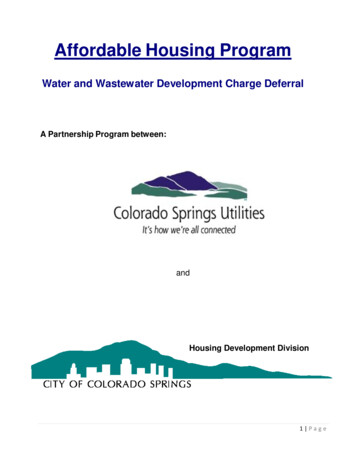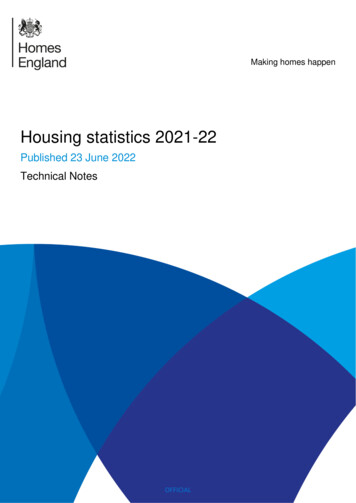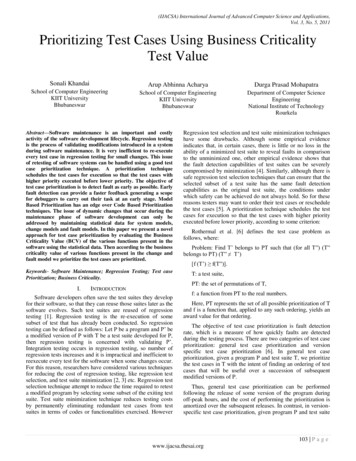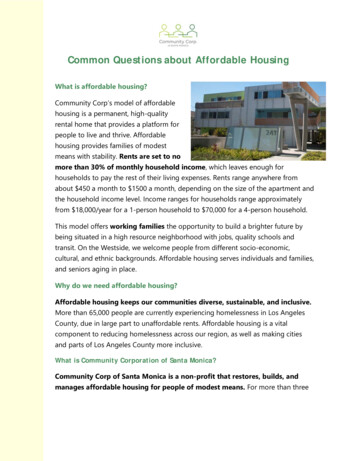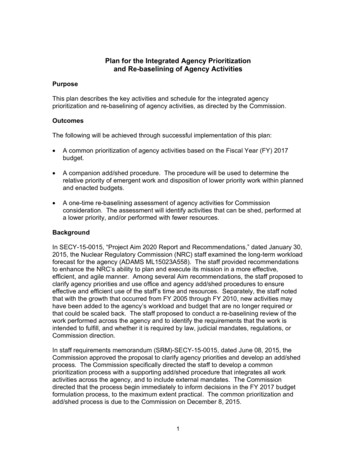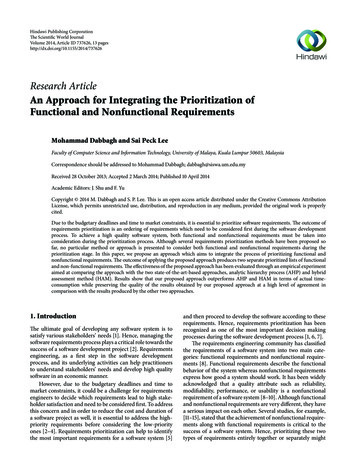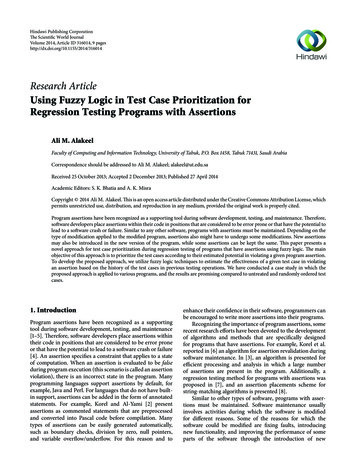
Transcription
AUDIT REPORTCity of AustinA Report to theAustin City CouncilMayorSteve AdlerMayor Pro TemKathie TovoPrioritization of AffordableHousing Development AuditNovember 2015Council MembersOra HoustonDelia GarzaSabino RenteriaGregorio CasarAnn KitchenDon ZimmermanLeslie PoolEllen TroxclairSheri GalloOffice of theCity AuditorActing City AuditorCorrie StokesCIA, CGAP, CFEDeputy City AuditorJason HadaviCPA, CFEREPORT SUMMARYThe City does not have an effective strategy to meet its current affordablehousing needs. Neighborhood Housing and Community Development has notadopted clear goals, established timelines, or developed affordable housingnumerical targets to evaluate its efforts in fulfilling the City’s adopted corevalues. Key information needed to evaluate program effectiveness isincomplete, inaccurate, or unavailable. Finally, current monitoring practicesdo not ensure consistent compliance with stipulated affordability restrictions.
AUDIT NUMBER: AU15102TABLE OF CONTENTSBACKGROUND .1OBJECTIVE, SCOPE, AND METHODOLOGY .4WHAT WE FOUND .5AppendicesAppendix A: Management Response .15Appendix B: Government Finance Office Association Establishment of Strategic Plans .31GOVERNMENT AUDITING STANDARDS COMPLIANCEWe conducted this performance audit in accordance with Generally Accepted Government AuditingStandards. Those standards require that we plan and perform the audit to obtain sufficient,appropriate evidence to provide a reasonable basis for our findings and conclusions based on ouraudit objectives. We believe that the evidence obtained provides a reasonable basis for our findingsand conclusions based on our audit objectives.AUDIT TEAMNiki Raggi, CGAP, CRMA, CICA, Assistant City AuditorNeha Sharma, CIA, CPA, CISA, Auditor-in-ChargeCaroline KirschnerMichael McGillOffice of the City Auditorphone: (512)974-2805email: oca auditor@austintexas.govwebsite: http://www.austintexas.gov/auditorCopies of our audit reports are available at portsPrinted on recycled paperAlternate formats available upon request
November 2015PRIORITIZATION OF AFFORDABLE HOUSINGDEVELOPMENT AUDITBACKGROUNDReport HighlightsWhy We Did This AuditThis audit was conducted as partof the Office of the City Auditor’s(OCA) fiscal year (FY) 2015Strategic Audit Plan, based onstakeholder concerns and issuesidentified in prior audits.What We RecommendNHCD should: initiate a policy discussionwith the City Council toevaluate the effectiveness ofthe City’s affordable housingpolicies in achieving the corevalues and community needs; ensure City affordable housingpolicies are prioritized andlinked to achieving establishedvalues; regularly report outcomesrelated to achievement of corevalues; coordinate with other Citydepartments to ensuretracking, monitoring, andreporting of housing projects;and allocate appropriate resourcesto ensure monitoring ofaffordability requirements.The City’s Neighborhood Housing and Community Development department(NHCD) supports the creation of affordable housing through its Housing DeveloperAssistance programs. These programs either provide financial assistance todevelopers to create affordable units or provide incentives, such as fee waivers ordensity bonus to developers, in exchange for setting aside affordable housingunits.The City has three affordable housing core values of deeper affordability, longeraffordability and geographic dispersion.OBJECTIVE AND SCOPEThe objective of this audit was to evaluate the effectiveness of NHCD strategicplanning efforts to prioritize and address the City’s affordable housing goals andneeds through Housing Developer Assistance programs.The scope included NHCD’s strategic planning and operations for the HousingDeveloper Assistance programs for the three year period from FY 2012 to FY 2014.WHAT WE FOUNDThere is not an effective strategy to ensure that the City meets its affordablehousing needs.1. Although NHCD has implemented elements of strategic planning, theseelements are not fully aligned. NHCD has developed some goals, but has notestablished timelines, or developed numerical targets to evaluate its efforts infulfilling the City’s affordable housing core values. For example:- there are no goals or numerical targets to measure progress towards thevalue of geographic dispersion; and- in the absence of clear goals and targets, it is difficult to evaluate theCity’s effectiveness in providing affordable housing, and any outcome canbe seen as a success.2. Key information needed to evaluate program effectiveness was incomplete,inaccurate, or unavailable:- We found flaws in how NHCD counts its affordable housing production,which resulted in NHCD significantly overstating its accomplishments increating affordable housing;NHCD has incomplete information on affordability restrictions for a largeportion of affordable housing units produced; andNHCD has incomplete information on the full costs of affordable housingproduction.3. NHCD has gaps in their monitoring processes for affordable units.For more information on this or anyof our reports, emailoca auditor@austintexas.gov
BACKGROUNDAustin has been growing at a rapid pace for the last several years. At the same time, there has beenan overall slower growth in the housing stock, with growth involving more expensive homes andapartments. These trends have resulted in a mismatchThe federal government definesbetween the housing that residents can afford andaffordablehousing as housing, forhousing available locally. In the context of currentwhichoccupantspay no more than 30market conditions, the City is facing significantpercent of their income for grosschallenges and plays a key role in addressing the needshousing costs, including utilities.of affordable housing for Austin’s low and moderateincome population.The Neighborhood Housing and Community Development (NHCD) department plays a critical role inaddressing the City’s affordable housing needs. Through a variety of programs (shown in Exhibit 1),NHCD provides housing services to eligible low and moderate income households. Such servicesrange from counseling renters who wish to become homebuyers, to providing loans for qualifyinghomebuyers that help them buy their first home, or to renters so that rent is more affordable. NHCDalso provides assistance to non-profit and for-profit developers to build rental and homeownershipaffordable housing.Programs and activities aimed at supporting the creation of affordable housing units are groupedand administered under the umbrella of the Housing Developer Assistance program and arecarried out primarily through three main programs, shown in Exhibit 1. We focused our audit on theHousing Developer Assistance program as it is the primary mechanisms through which NHCDincreases the City’s affordable housing stock and due to the significant amount of federal and localfunding allocated to it. For example, in FY 2015, out of the 17 million of total funding for housingprograms, approximately 10 million was allocated to this program.EXHIBIT 1NHCD Housing ProgramsSOURCE: City of Austin Fiscal Year 2013-14 Budget, July 2015Office of the City Auditor1Prioritization of Affordable Housing Development Audit
As shown in Exhibit 1, through Rental Housing Developer Assistance and Acquisition andDevelopment, NHCD provides direct financial assistance to developers to create affordable housingfor rental and homeownership. These programs are entirely managed by NHCD. Through DeveloperIncentive programs, the City provides incentives such as fee waivers or density bonuses todevelopers who set aside a portion of units as affordable. These programs, which include theSMART (Safe, Mixed-Income, Accessible, Reasonably-priced1, Transit-Oriented) Housing PolicyInitiative and UNO (University Neighborhood Overlay), are implemented in coordination with otherCity departments. Based on City policies for SMART housing, NHCD is the lead agency empowered toassume a leadership role in working with other City departments to assist in the successfuldevelopment of SMART housing projects. For other developer incentive programs, such as densitybonuses, NHCD has the responsibility for establishing compliance and monitoring rules and criteriafor implementing the affordability requirements.Affordability requirements associated with Housing Developer Assistance programs includerestrictions on the income level of the occupants and on the period of time units are to remainaffordable. Exhibit 2 includes the affordability restrictions for Housing Developer Assistanceprograms.EXHIBIT 2Affordability Restrictions for Housing Developer Assistance ProgramsSOURCE: OCA review of NHCD Program Guidelines, May 2015Income levels are defined based on the area median family income (MFI). Federal housing programsdivide low and moderate income households into different categories based on their relationship tothe MFI. The current MFI for Travis County, Texas is 76,800 (4-person household). Current incomelimits by household size based on the formula used by the federal government are shown in Exhibit3 below.1Reasonably priced refers to units that have affordability restrictions.Office of the City Auditor2Prioritization of Affordable Housing Development Audit
EXHIBIT 3Current Median Family Income (MFI) Limits by Household Size (June 2015)SOURCE: City of Austin Website, June 2015Office of the City Auditor3Prioritization of Affordable Housing Development Audit
OBJECTIVE, SCOPE, AND METHODOLOGYThis Prioritization of Affordable Housing Development Audit was conducted as part of the Office ofthe City Auditor’s (OCA) Fiscal Year (FY) 2015 Strategic Audit Plan, as presented to the City CouncilAudit and Finance Committee. This audit was included on the Strategic Audit Plan due to risksobserved through prior work by our office, as well as concerns raised by City Council.ObjectiveThe objective of the audit was to evaluate the effectiveness of NHCD strategic planning efforts toprioritize and address the City’s affordable housing goals and needs through Housing DeveloperAssistance programs.ScopeThe audit scope included NHCD’s strategic planning and operations (housing production andmonitoring activities) for Housing Developer Assistance programs for the three year period from FY2012 to FY 2014.MethodologyTo accomplish our audit objectives, we performed the following steps: interviewed NHCD personnel responsible for strategic planning, reporting, and monitoring ofproduction data;interviewed community members, including those that have served on the CommunityDevelopment Commission, Housing Bond Advisory committee, and Affordable HousingIncentives task force;selected a judgmental sample of projects, for which outcomes were reported by NHCD, andreviewed reported outcomes for accuracy and completeness using source data;analyzed the reported outcomes of the developer incentive programs for reasonably pricedunits and reconciled to available source data;evaluated judgmental samples of projects for monitoring activities based on establishedrequirements for various programs;researched best practices for the strategic planning process;reviewed applicable NHCD policies and procedures;reviewed NHCD goals and performance measures;reviewed relevant external reports, including consultant market studies and reports publishedby the City in FY 2009 and FY 2014 and the Fair Housing Choice report in May 2015;evaluated internal controls related to strategic planning, reporting, and monitoring ofproduction data; andevaluated risks of fraud, waste, and abuse relevant to reporting and monitoring of productiondata.Office of the City Auditor4Prioritization of Affordable Housing Development Audit
WHAT WE FOUNDThe continuing high cost of housing in Austin increases the need to provide affordable housing tohouseholds with varied income levels, especially those with low and very low income levels. Theprovision of adequate affordable housing remains a significant challenge for Austin. We found thatthe City does not have an effective strategy to meet its current or anticipated affordable housingneeds. NHCD has not adopted clear goals, established timelines, or developed numerical targets toevaluate its efforts in fulfilling the City’s adopted affordable housing core values. Key informationneeded to evaluate program effectiveness was incomplete, inaccurate, or unavailable. Finally,current monitoring practices do not ensure consistent compliance with stipulated affordabilityrestrictions.Finding 1: The City does not have an effective strategy to create housing with deeperaffordability, longer affordability, and geographic dispersion.According to best practices, a strategic planning process as depicted in Exhibit 4 below is importantto identify priorities, set goals, define key actions, and communicate to stakeholders. In this manner,organizations can influence the future rather than simply preparing for or adapting to it. Bestpractices also identify performance measures as an important link between the goals, strategies,actions, and objectives stated in the strategic plan and the programs and activities funded in thebudget. Performance measures provide information on whether goals and objectives are being met.EXHIBIT 4Strategic Planning Best PracticeSOURCE: OCA Analysis of Government Finance Officers Association – Establishment of Strategic Plans, July 2015Although NHCD has implemented elements of strategic planning, these elements are not fullyaligned. For example, NHCD has adopted guiding principles, identified affordable housing needs, andset some goals. It has also developed operational plans and performance measures. However, basedon our analysis, these elements are not clearly aligned and linked to illustrate how all elementssupport the achievement of the identified needs and guiding principles. NHCD does not have acomprehensive document that clearly communicates to the public and stakeholders all keypriorities, goals for addressing them, and numerical targets to evaluate the department’s efforts. Asshown in Exhibit 5, available documents include some goals and performance measures, but somedo not directly align or measure achievement of core values.Office of the City Auditor5Prioritization of Affordable Housing Development Audit
EXHIBIT 5Goals and Performance Measures Do Not Align with Core ValuesSOURCE: OCA analysis of City of Austin Budget for Fiscal Years 2012 through 2015, July 2015Furthermore, recent studies have recommended that the City establish a target for affordablehousing and that all City programs and policies should be linked to the achievement of theestablished Citywide target. NHCD has initiated a discussion aimed at identifying relevant goals toaddress specific affordable housing gaps for both the City andthe community. NHCD has also initiated a process of revisinggoals and measures and has already implemented somechanges in the FY 2016 budget cycle. However, ourobservations are still applicable. For example, there is still nomeasure of the efficacy of geographic dispersion, and there isno longer a goal that speaks to the core value of longeraffordability. We also noted there are limited measuresof efficiency for housing programs overall (comparing outcomesto resources consumed to achieve those outcomes).The core values mentioned above were adopted by the City of Austin in 2007 to serve as guidingprinciples for all City’s housing policies and programs. Also, in 2008 and 2014, the City hired aconsultant to conduct a comprehensive housing market analysis. Such studies, which are conductedto be in compliance with federal grants requirements, are used to identify the most significanthousing needs of the community. The most significant needs identified in the 2014 comprehensivehousing market study were: 48,000 rental units for households at 30% MFI or less, and homeownership units for households at 50% MFI or less.Office of the City Auditor6Prioritization of Affordable Housing Development Audit
In the absence of clear goals and numerical targets, it is difficult to evaluate the City’seffectiveness in providing affordable housing, and any outcome can been seen as a success.Having relevant performance measures related to a defined goal enables tracking of actualoutcomes and reporting of accomplishments. Without such information, it is difficult to evaluateNHCD’s effectiveness in providing affordable housing in alignment with the affordable housing corevalues. Furthermore, in the absence of clear goals and numerical targets, any outcome can betreated as a success.As discussed in the background section of this report, Housing Developer Assistance programspromote affordable housing through the Rental Housing and Developer Assistance (RHDA) and theAcquisition & Development programs (A&D), which provide direct funding to developers ofaffordable housing. Affordable housing is also achieved through providing incentives to developers,such as the SMART housing initiative, which waives all or a portion of development fees in exchangefor a portion of affordable units. For the directly funded programs, NHCD manages all aspects of theprogram and thus has more flexibility in defining program requirements and influencing programoutcomes. For developer incentive programs where there is an affordable housing component,NHCD’s role focuses on monitoring and compliance to ensure that the affordability restrictionsestablished by the City Council are met.As discussed later in this report, we identified several limitations regarding available data onaffordable housing units created. However, for the purpose of evaluating NHCD’s accomplishmentsin addressing the adopted values, we estimated Housing Developer Assistance program’sproduction. While we believe these revised numbers are not exact, they can be used as a generalindicator of NHCD accomplishments in contributing to increasing the affordable housing stock.Deeper affordabilityBased on available documentation and our estimates of affordable units created in the scope periodunder Housing Developer Assistance, it appears that the majority of outcomes resulted in affordablehousing opportunities that benefit households in the 50% to 80% MFI bracket, as shown in Exhibit 6.EXHIBIT 6Estimated FY 2012 - FY 2014 Production Data of Housing Developer Assistance Programs by MFISOURCE: OCA analysis of NHCD production data, September 2015Office of the City Auditor7Prioritization of Affordable Housing Development Audit
Longer affordabilityLooking at the overall number of affordable units created in our scope period under HousingDeveloper Assistance programs, based on our estimated numbers and available documentation, itappears that the majority of units have affordability restrictions for 5 years or less 2, as shown inExhibit 7.EXHIBIT 7Estimated FY 2012 - FY 2014 Production Data of Housing Development Assistance Programsby Affordability PeriodSOURCE: OCA analysis of NHCD production data, September 2015Geographic dispersionIn this audit, we did not comprehensively evaluate whether NHCD production was in alignment withthe core value of geographic dispersion. However, we did note that a number of studies reportedthat City initiatives to create affordable housing may not be equitably distributed throughout Austinand may not serve the households with the greatest needs. Although some of these studies citeddata limitations, the reports consistently concluded that there are geographically limitedopportunities for low-income households in Austin. While NHCD applies a specific tool ofmeasurement (the Kirwan Opportunity Map) in scoring geographic dispersion of projectapplications and provides high points for geographic dispersion if the project is in high opportunityarea3, the department does not have a specific goal or measure as shown in Exhibit 5.Includes units that received funding from the Texas Department of Housing and Community Affairs; althoughthese units may have a longer affordability period, the City monitors affordability requirements for 5 years.3High Opportunity Area: geographic criteria used by NHCD that considers quality of life and self-advancementthrough indicators of neighborhood conditions and proximity to opportunities such as high performingeducation or sustainable employment.2Office of the City Auditor8Prioritization of Affordable Housing Development Audit
Finding 2: Incomplete and inaccurate data limits NHCD’S ability to evaluate programsuccess and to provide accurate information to the decision-makers and public.As stated in Exhibit 4, data is an important component of the strategic planning process. Based onbest practices, policy makers, executives, managers, and staff must have performance data in orderto track and understand results. Data-informed decision-making allows the organization to learnfrom experience, replicate successful strategies, and improve on efforts that fail to meetexpectations. Data should be timely, accurate, and meaningful. Information related toperformance should also be transparent and easy to access, use, and understand.In the context of this audit, in order to have a complete picture of the impact of its programs and beable to present complete and relevant information for decision-making, NHCD should have accurateand meaningful data on its affordable housing production. This includes a complete count ofaffordable units created, information on the affordability period and income levels served, as well asinformation on how much it costs the City.We reviewed the data on affordable housing production reported by NHCD under HousingDeveloper Assistance programs and found that key information needed to evaluate programeffectiveness was incomplete, inaccurate, or unavailable. These issues were prevalent for datarelated to the developer incentive programs, in which the City waives developer fees. NHCDreported production of developer incentive programs in FY 2012-14 include units resulting fromSMART housing projects (87% approx.) and from UNO projects (13% approx.).Inaccurate counting of affordable housing production resulted in NHCD overstating the City’saccomplishments in creating affordable housing.Through our analysis, we found flaws in the manner NHCD counts affordable housing unitsproduced. Exhibit 8 illustrates, for the Housing Developer Assistance program, the count ofaffordable housing units produced as reported by NHCD compared to the count as verified throughour testing.EXHIBIT 8Flaws in FY 2012-2014 Production Data Resulted in Overstated OutcomesSOURCE: OCA analysis of NHCD production data, September 2015Office of the City Auditor9Prioritization of Affordable Housing Development Audit
EXHIBIT 9Over Half of Units Reported as Affordable Housing by NHCD Were Not AffordableNHCD reported a total ofapproximately 5,000 affordableunits during FY 2012-2014; basedon our analysis, this amount isoverstated by approximately3,000 units (or 58%)SOURCE: OCA analysis of NHCD production data, September 2015As shown in Exhibit 9, errors in the counting of affordable housing production for developerincentive programs have resulted in NHCD overstating its accomplishments and in providinginaccurate information to the public and decision-makers, as detailed below. Market value units counted as affordable housing outputs: we found that NHCD reported asaffordable all units resulting from the SMART and UNO housing projects in the scopeperiod, regardless of whether they had affordability requirements. This resulted in NHCDincorrectly reporting approximately 2,600 market value units as affordable. Duplicate counting among different programs: we found approximately 400 units that werecounted twice as outputs, once under each of the programs they benefitted from.In addition to overstating affordable housing production, these errors also impact otherperformance indicators. For example: total number of households served through housing services (one of NHCD’s key performanceindicator) was overstated by approximately 28%; and total number of households served through all NHCD services (one of the Citywide “dashboard”measure) was overstated by approximately 15%.Incomplete information on affordability restrictions for housing units limits NHCD’s ability toevaluate whether it is achieving the intent of its programs.City policies establish that affordable housing units created through City programs meet certainaffordability restrictions regarding income eligibility (MFI served) and length of time each units isrequired to be kept affordable (affordability period) as shown in Exhibit 2 of the background section.As such, for program evaluation purposes, it is important to have complete and accurate data on themanner in which these affordability restrictions are met.However, we found that NHCD does not track and report complete information on the actualincome levels (MFI) of the households served and the actual affordability period of the unitscreated. For units created through directly funded programs, NHCD tracks MFI data and affordabilityperiod information based on actual information obtained at the time an affordable unit is occupied.However, for the units created under the developer incentive programs, NHCD does not haveOffice of the City Auditor10 Prioritization of Affordable Housing Development Audit
information about the actual MFI 4. Rather, available information is limited to the commitmentsmade by the developers prior to beginning construction.Incomplete information on the full cost of affordable housing production limits NHCD’s ability toevaluate program effectiveness.When resources are scarce, it is essential to know where program activities are making a differenceand where they are not. Cost is an important component of evaluating program success.Under the SMART housing policy, NHCD has the authority to waive fees to those developments thatmeet the SMART housing requirements. However, NHCD does not have complete information onthe numbers and amounts of fees waived, resulting in incomplete project costs. Specifically: NHCD does not regularly track amounts of fees waived under SMART housing projects. NHCD project cost includes only funding received from the City and does not capture other coststo the City, such as fee waivers for SMART Housing or tax subsidies provided throughpartnership agreements.According to NHCD data, the total amount of fees waived in our scope period is approximately 4.6million. Fees are waived by several departments at various stages in the development process.However, there is no routine tracking of information on the number or types of fees waived andtheir associated cost. As already noted in a 2002 audit performed by our office, fee waivers are notaccounted for in any City budget program. Also, fees are not entirely captured in the City’spermitting system, as there are several fees that are manually assessed and recorded.Without timely, relevant, and accurate information, it may be difficult for NHCD to evaluate thesuccess of its programs and to provide meaningful information to the City Council.As discussed earlier in this finding, an incorrect count of affordable housing production resulted inNHCD reporting overstated performance information. We also noted some limitations in theinformation provided to the City Council as part of the recent discussion on revisions to theDevelopment Incentives and Density Bonus policies. Specifically, for the two slides shown inExhibit 10, which were presented to Housing and Community Development Committee on March25, 2015, we noted that:1. Total affordable units reported for the SMART Housing program is incorrect, as NHCD’s count ofaffordable units was overstated.2. Data does not take into account the affordability period. As the data presented to Councilincluded the units produced since 2000, a large portion of the units reported are no longeraffordable. In fact, units developed under the SMART housing program are required to be keptaffordable no more than 5 years, which means that a large portion of the units reported in theslide are no longer required to be affordable.3. An additional piece of information that might be useful to inform the decision-making process isthat units developed through development incentives (as opposed to directly funded) are notbound by specific requirements on affirmative marketing and tenant selection.4With the exception of those produced under the Robert Mueller Municipal Airport (RMMA) developmentagreement, which are monitored by a third party.Office of the City Auditor11 Prioritization of Affordable Housing Development Audit
EXHIBIT 10Example of Inaccurate Data Presented to City CouncilSOURCE: City Council Housing Committee, March 25, 2015Affordable housing production data is stored in several stand-alone systems rather than one centralsystem. Systems include the City’s performance measure database, the federal government’sreporting system, and the City’s permitting system. In addition, these systems do not alwaysprovide user-friendly reporting. For example, we noted that the reports generated through thepermitting system are adjusted manually by staff to report production.Further, we noted gaps in the communication and coordination among the groups that haveresponsibilities for the three programs we looked at. We observed that not all staff responsible fortracking units produced has the same understanding of how to track and report units.NHCD management informed us that NHCD currently la
City departments. Based on City policies for SMART housing, NHCD is the lead agency empowered to assume a leadership role in working with other City departments to assist in the successful . Office of the City Auditor 2 Prioritization of Affordable Housing Development Audit . EXHIBIT 3 . Current Median Family Income (MFI) Limits by Household .
